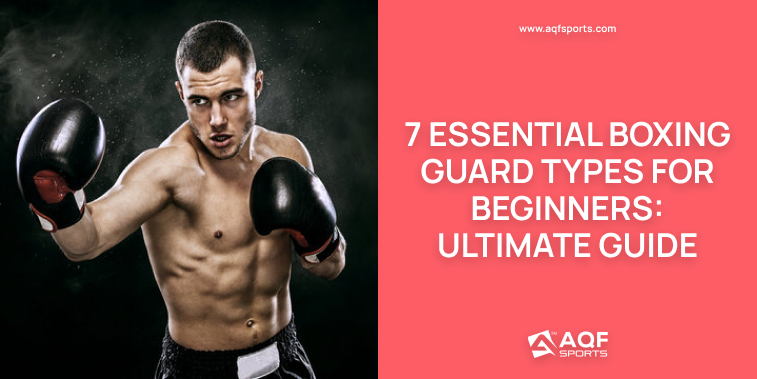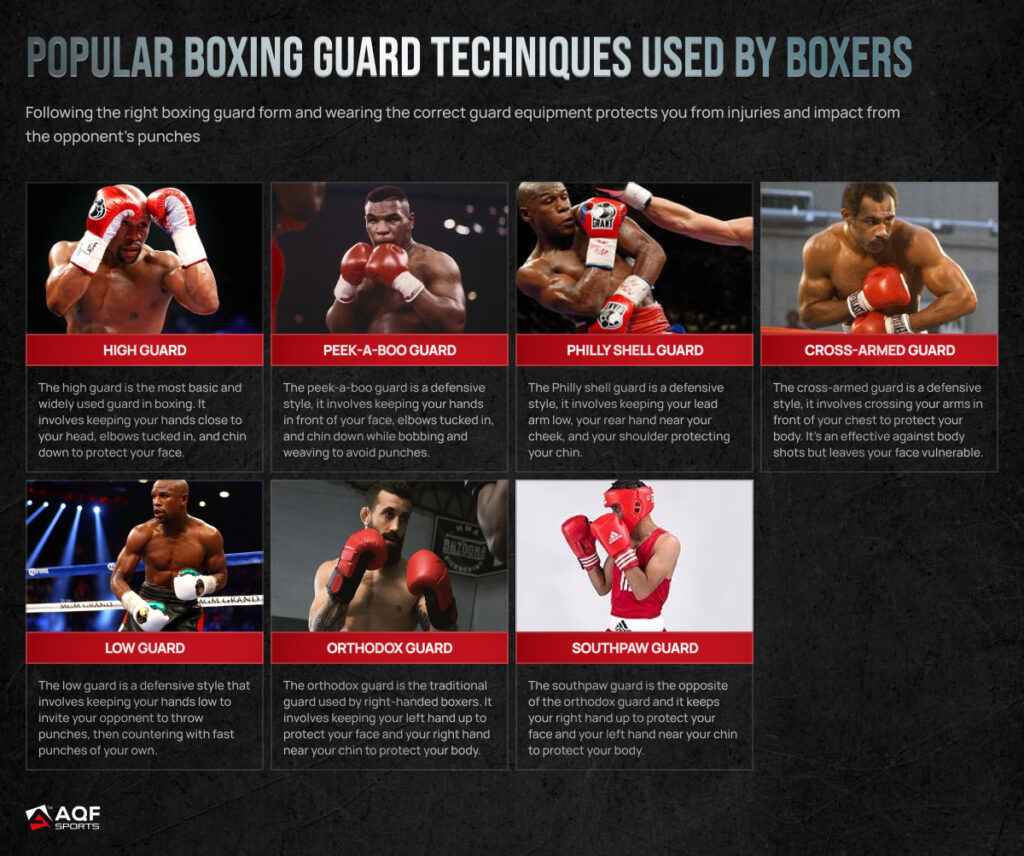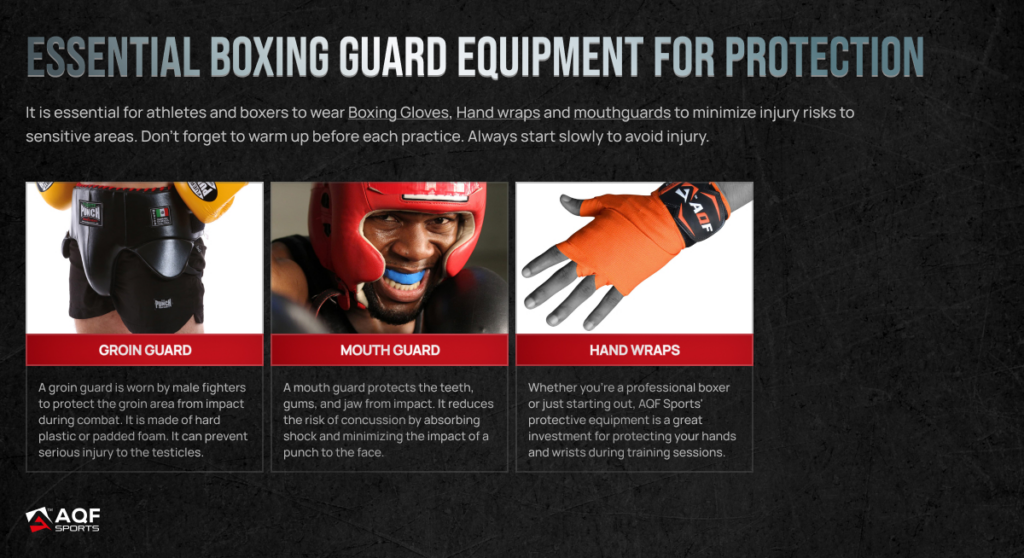7 Essential Boxing Guard Types for Beginners: Ultimate Guide

Boxing builds strength, endurance, and confidence. To gain these benefits, it’s essential to practice proper boxing using the right equipment to avoid injury. Following the right boxing guard form and wearing the correct guard equipment protects you from injuries and impact from the opponent’s punches.
In this article, we’ll cover the top 7 boxing guard types for beginners as well as the importance of essential boxing guard equipment.
Popular Boxing Guard Techniques Used by Boxers
High Guard
The high guard is the most basic and widely used guard in boxing. It involves keeping your hands close to your head, elbows tucked in, and chin down to protect your face.
Pros
- Offers great protection for the face and head.
- Easy to learn and use.
- Works well against a variety of punches.
Cons
- Can be tiring to maintain for long periods.
- Limits the ability to throw fast punches.
- Offers less protection for the body.
Ideal for
Beginners who want to learn the basics of boxing and are looking for a simple, effective guard.
Peek-a-Boo Guard
The peek-a-boo guard is a defensive style created by legendary boxer Cus D’Amato. It involves keeping your hands in front of your face, elbows tucked in, and chin down while bobbing and weaving to avoid punches. The peek-a-boo guard is best for parry punches. The guard emphasizes keeping the hands up and in front of the face, which makes it easier to quickly deflect or parry incoming punches.
Pros
- Offers great protection for the face and head.
- Allows for quick and effective counterpunching.
- Helps to conserve energy by minimizing unnecessary movements.
Cons
- Takes time and practice to perfect.
- Can be difficult to maintain against taller opponents.
- Leaves the body more vulnerable to punches.
Ideal for:
Intermediate to advanced boxers who want to incorporate a more complex and dynamic guard into their style.
Philly Shell Guard
The Philly shell guard is a defensive style popularized by Floyd Mayweather Jr. It involves keeping your lead arm low, your rear hand near your cheek, and your shoulder protecting your chin.
Pros
- Offers great protection for the entire body.
- Allows for quick and effective counterpunching.
- Provides opportunities for offensive maneuvers.
Cons
- Takes time and practice to master.
- Can be difficult to use against taller opponents.
- Leaves the head and face more vulnerable to punches.
Ideal for: Advanced boxers who want to incorporate a unique and defensive style into their repertoire.
Cross-Armed Guard
The cross-armed guard is a defensive style that involves crossing your arms in front of your chest to protect your body. It’s an effective guard against body shots but leaves your face vulnerable.
Pros
- Offers great protection for the body.
- Provides opportunities for counterpunching.
- Can be used to lure opponents into attacking.
Cons
- Leaves the head and face more vulnerable to punches.
- Can be difficult to use against taller opponents.
- Limits the ability to throw fast punches.
Ideal for: Boxers who want to focus on body shots and are looking for a unique and defensive style.
Low Guard
The low guard is a defensive style that involves keeping your hands low to invite your opponent to throw punches, then countering with fast punches of your own.
Pros
- Can be used to bait opponents into attacking.
- Allows for quick and effective counterpunching.
- Provides more opportunities to land punches to the head and body.
Cons
- Leaves the head and face more vulnerable to punches.
- Requires good footwork and defensive skills.
- Can be tiring to maintain for long periods.
Ideal for: Boxers who are comfortable with their defensive skills and want to incorporate a more aggressive and counterpunching style.
Orthodox Guard
The orthodox guard is the traditional guard used by right-handed boxers. It involves keeping your left hand up to protect your face and your right hand near your chin to protect your body.
Pros
- Offers great protection for the face and head.
- Easy to learn and use.
- Works well against a variety of punches.
Cons
- Can be tiring to maintain for long periods.
- Limits the ability to throw fast punches.
- Offers less protection for the body.
Ideal for: Right-handed beginners who want to learn the basics of boxing and are looking for a simple, effective guard.
Southpaw Guard
The southpaw guard is the opposite of the orthodox guard and is used by boxers who use their left lead hand. It keeps your right hand up to protect your face and your left hand near your chin to protect your body.
Pros
- Offers great protection for the face and head.
- Easy to learn and use.
- Works well against a variety of punches.
Cons
- Can be tiring to maintain for long periods.
- Limits the ability to throw fast punches.
- Offers less protection for the body.
Ideal for:
Left-handed beginners who want to learn the basics of boxing and are looking for a simple, effective guard.
Read our article on How to Punch Harder? Mistakes to Avoid & Tips to Follow.

Essential Boxing Guard Equipment for Protection
Groin Guard
A groin guard, also known as a cup, is worn by male fighters to protect the groin area from impact during combat. It is made of various materials, including hard plastic or padded foam. A well-fitted groin guard can prevent serious injury to the testicles. So, it prevents pain and long-term damage.
Pros
- Protects the sensitive groin area from impact and injury.
- Gives boxers peace of mind and confidence when sparring or competing.
- Available in various types and designs, including hard cups and soft padding.
Cons
- Can be uncomfortable and restrict movement if not fitted properly.
- It may move out of place during intense movement or impact.
- May not fully protect from all types of blows or hits to the groin area.
Ideal for:
Boxers and other combat sports athletes who want to protect their groin area from impact and injury.
Mouth Guard
A mouth guard protects the teeth, gums, and jaw from impact. It reduces the risk of concussion by absorbing shock and minimizing the impact of a punch to the face. A mouth guard is typically made of a soft, pliable material that molds to the teeth and can be customized to fit the individual’s mouth.
Pros
- Protects the teeth, gums, and jaw from impact during sparring or competitions.
- Can improve breathing and oxygen intake during physical activity.
- Can improve overall comfort and reduce distractions during training or competitions.
Cons
- Can feel bulky or uncomfortable, especially if not fitted properly.
- May interfere with speech or communication during training or competitions.
- Can be easily lost or forgotten.
Ideal For:
- Boxers and other combat sports athletes who want to protect their teeth, gums, and jaw from impact.
- Athletes who have previously experienced dental or jaw injuries or those who grind their teeth during physical activity.

Useful Tip:
It is essential for athletes and boxers to wear Boxing Gloves, Hand wraps and mouthguards to minimize injury risks to sensitive areas. Don’t forget to warm up before each practice. Always start slowly to avoid injury.
Boxing Guard – Frequently Asked Questions
What happens when a boxer loses his mouthguard?
If a boxer loses their mouthguard during a match, the referee will usually pause the fight to allow the boxer to retrieve the mouthguard or replace it. If the mouthguard is damaged or cannot be retrieved, the boxer may be given a new mouthguard to use. In some cases, if the boxer loses their mouthguard repeatedly or if it is seen as an intentional tactic to gain a breather, the referee may issue a warning or even a penalty. It is important for boxers to properly fit and secure their mouthguards to prevent them from becoming dislodged during a fight.
Is it better to wear a mouthguard on top or bottom?
Both types of mouthguards, whether worn on the top or bottom teeth, can provide sufficient protection for the teeth and mouth. However, it is generally recommended to wear a mouthguard on the top teeth, as it provides a better fit and protection to the upper teeth, which are more vulnerable to impact during a boxing match.
How do you pick a good mouthguard?
- Fit: A good mouthguard should fit snugly and comfortably in your mouth. It should not feel loose or bulky.
- Thickness: The mouthguard should be thick enough to provide adequate protection, but not so thick that it hinders breathing or speech.
- Material: Mouthguards are typically made from three types of materials: stock mouthguards, boil-and-bite mouthguards, and custom-fit mouthguards. Custom-fit mouthguards are the most expensive but also offer the best protection.
- Purpose: Consider the purpose of the mouthguard. If you’re a professional boxer, you may need a different type of mouthguard than if you’re a beginner or recreational boxer.
- Durability: Look for a mouthguard that is made from high-quality materials and is designed to last. A durable mouthguard will offer better protection and save you money in the long run.
- Hygiene: Look for a mouthguard that is easy to clean and maintain. A mouthguard that is not cleaned properly can harbor bacteria and lead to oral health problems.
Are you supposed to bite on your mouthguard?
Yes, you are supposed to bite on your mouthguard to help it stay in place and provide the best protection. When fitting a mouthguard, you should bite down firmly to make sure it conforms to the shape of your teeth and gums. However, you should not bite down too hard or clench your teeth while wearing a mouthguard, as this can cause jaw pain and affect your performance.
How do you know if a mouthguard is good?
fit comfortably and securely in your mouth, allowing you to speak and breathe easily while providing protection for your teeth, jaws, and soft tissues.
Did Mike Tyson wear a mouthpiece?
Yes, Mike Tyson wore a mouthpiece during his boxing matches. A mouthpiece is a protective device that is worn in the mouth to help absorb shock and protect the teeth and jaws from injury during physical activities such as boxing. It is a mandatory piece of equipment for boxers in most jurisdictions.
Conclusion
In conclusion, mastering the different types of boxing guards is crucial for beginners to become successful in boxing. By following the step-by-step instructions and utilizing the equipment needed, you can ensure that you’re well-protected while practicing. Start practicing today and take your boxing skills to the next level!
Also Read:






